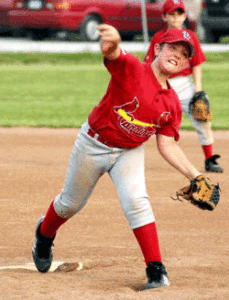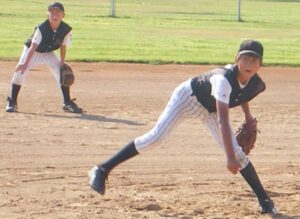Your Arm Hurts? Thank Your Little League, AAU, and Fall Ball Coaches.
I have a policy when it comes to my writing:
If something is going to be controversial and potentially elicit a negative response from my readers, I "sit" on the topic for 24 hours. During that time, I weigh the decision of whether me publicly writing about something is for the better good – meaning that it'll help people in the long-term even if it makes them recognize that they've been goofing up in the short-term.
I did some thinking on that front last night (actually, for the past several nights), and decided to go through with this blog, as I feel like it's something that every single baseball player, parent, and especially coach ought to read. So, if you're in one of those categories – or are just a baseball fan who loves the game – please spread the word on what you're about to read, whether it's with a Facebook "recommend," "Tweet," or just a friendly email with the link to this article.
If you've perused my Baseball Content page much in the past, you'll know that I don't try to hide the fact that throwing a baseball is an incredibly unnatural and flat-out dangerous motion. It's the single-fastest motion in all of sports, and every day, physically unprepared athletes go out and essentially play with fire every single time they try to light up a radar gun – or even just play catch.
Not surprisingly, when you mix physically unprepared bodies with arguably the most dangerous sporting challenge on the planet (the folks in Pamplona, Spain might argue with me, but that's a blog for another day), athletes get hurt. Arm injuries (like all youth sports injuries) are rising exponentially thanks to not "less athletic athletes" taking part in high-risk sports, but also this participation taking place at all-time high rates thanks to the proliferation of little league all-star teams, AAU teams, fall ball, private pitching instruction, and the baseball showcase industry. A fantastic study by Olsen et al. in 2006 (must-read for anyone involved in baseball development) clearly demonstrated strong associations between injuries requiring surgery and pitching "more months per year, games per year, innings per game, pitches per game, pitches per year, and warm-up pitches before a game" as well as showcase appearances during adolescence. The message was very clear: throw too much – especially at a young age – and you're going to wind up hurt.
Unfortunately, though, many people glaze over numbers in studies (if they ever read them), and while they may walk away with the "overuse is bad" message, they don't appreciate what true overuse really is – especially since it's age-dependent. Fortunately, a February 2011 study from Fleisig et al. showed in no uncertain terms that, in ages 9-14, throwing more than 100 innings per year was associated with a 3.5 times higher risk of elbow or shoulder surgery – or retirement altogether.
To put this into context, I'll first ask you: do you realize how challenging it is to throw 100 innings in a little league season? Let’s say you start baseball the first week of April (little league) and even manage to play on a summer team that runs through the end of July. That’s a four month season: exactly what I was accustomed to growing up – at the absolute most.
If you look at the Major League Baseball leaders in innings pitched, those at the top of the list generally throw about 35 innings per month (4-5 starts each). In other words, high-performance, skeletally mature pitchers in the most elite baseball league in the world are on pace for roughly 140 innings pitched over the first four months of the year. However, there are parents and coaches out there that actually think it's okay to send an 11-year old out there for a comparable number of innings? It's especially troublesome when you realize that younger kids always throw more pitches per inning than their older counterparts, as they don't have good command and insist on trying to strike everyone out instead of pitching to contact here and there.
Just think about how hard that is to do. Major League pitchers throw on a five-day rotation, and Little league games are, at most, twice a week. If a kid pitches once a week for four months, even if he throws complete games every time out (not something I'd advise, for the record), he'd still struggle to hit 100 innings (16 starts x 7 inning games =112 innings). Rats! It's actually tough to overuse kids when the season is kept in check.
So, instead, they add seasons. Join an AAU team (or seven of them). Play fall ball so that you can rack up another seven innings every weekend. Be sure to hit up a few college camps on Saturdays and throw as hard as you can so that your Sunday outing in 25-degree weather is extra miserable. Make sure you see your pitching coach for bullpens as soon as fall ball ends. Get your registration in early for that showcase that's taking place the first week in January. Just do some band work and a couple of half-ass stretches and you'll be fine. Riiiight….good thinking.
At risk of sounding arrogant, I'm good at what I do. I've devoted my life to keeping baseball players healthy. They comprise 85% of our clientele at Cressey Performance, and I work with millions of dollars of arms every off-season and see players from ages 9 to 50+. I do my best to surround myself with the smartest people in strength and conditioning, rehabilitation, and skill-specific training in and outside of the game. I managed the first subpectoral biceps tenodesis in major league history. I can talk mechanics with the best pitching coaches around, write strength and conditioning and throwing programs, manually stretch guys, you name it. I've got two fantastic therapists in my office to do massage, ART, Graston, chiropractic adjustments, and a host of other manual therapy approaches – not to mention great physical therapists nearby who can handle all our complex cases. You know the only things I, we, or anybody on this planet can't control?
Poor judgment by athletes and their parents and coaches.
And that – no doubt about it – is the primary reason that kids get hurt. We can do all the strength training, mobility work, and soft tissue treatments in the world and it won't matter if they're overused – because I'm just not smart enough to have figured out how to go back in time and change history. Worried about whether they're throwing curveballs, or if their mechanics are perfect? It won't matter if they've already accumulated too many innings.
While athletes might be playing with fire each time they throw, the pain presentation pattern is different. You burn your hand, and you know instantly. Pitching injuries take time to come about. Maybe you do microscopic damage to your ulnar collateral ligament each time you throw – and then come back and pitch again before it's had time to fully regenerate. Or, maybe you ignore the shoulder internal rotation deficit and scapular dyskinesis you've got and it gets worse and worse for years – until you're finally on the surgeon's table for a labral and/or rotator cuff repair. These issues might be managed conservatively if painful during the teenage years (or go undetected if no pain is present) – but once a kid hits age 18 or 19, it seems to automatically become "socially acceptable" to do an elbow or shoulder surgery.
Of course, this isn't just applicable to coaches in the 9-14 age group. You see "criminal" pitch counts in the high school and collegiate ranks as well, and while they may be more physically mature than the 9-14 year-olds, that doesn't mean that they're exempt from the short- and long-term consequences.
This is why we need the best coaches at the youngest levels. It's also why we need pitching coaches that understand "managing pitchers" as much as – if not more than – teaching pitching mechanics. And, it's why coaches need to understand the big picture in terms of what different kids can do at different ages, at different times in the year.
It's also while parents need to be proactive with their young pitchers. If a coach isn't going to track his innings – and a 9-year-old kid certainly can't be expected to do so – the parent needs to step up and do so. I've met a lot of parents of kids who have been injured at ages 17-21, and most of them look back with a lot of anger toward coaches at younger levels for overusing their sons. Hindsight is always 20/20, but foresight is what saves an arm. Don't be afraid to step up and say something, as you aren't telling a coach how to do his job; you're protecting your kid, just as you would be locking the door at night or making sure he brushes his teeth.
In terms of planning the competitive year, I have no problem with a 9-14 year-old kid playing baseball 4-5 months of the year, as the other 7-8 months per year should be devoted to at least two other sports. It's basically the "rule of thirds" for long-term athletic development: three sports, four months apiece. Kids can strength-train year round.
At ages 15-16, I'm fine with kids changing things up and going to only two sports. Baseball might occupy 7-8 months, but a big chunk of that should be focused on preparation. So, a kid might start playing catch in November, start his high school season in March, and then play summer ball through the end of July. August through November would be devoted to a fall sport and fall ball would be altogether omitted, as it was the only idea worse than making Rocky V. Kids would, of course, strength-train year-round.
At ages 17 and up, it's fine with me if you want to specialize in baseball, but that doesn't mean you should play year-round. I actually advocate kids only throw for 8-9 months of the year (at most) – which is right on par with what most professional players do. The only thing that'd be different is that the season would be shifted up a bit in the year, as the high school season usually starts a few weeks before the professional season. Pro guys get half of October, then all November and December off from throwing. "Specialized" high school players get August, September, and October off (again, because fall ball is as useful as a trap door in a lifeboat). Strength training is year-round.
You'll notice that there isn't a single penny spent on off-season baseball showcases. That wasn't an accidental omission (read here why I don't like them). If you insist on going to one, pick one between June and early August.
I'm convinced that the next big thing in Major League Baseball's "scouting revolution" is meticulously analyzing what players did when they were younger. If they are going to draft kids, they want to know that they haven't been overworked for years prior to entering professional baseball. You're already seeing this taking place in collegiate baseball based more on an assumption: pitchers from the North are getting more and more opportunities to play down South because coaches recruit them (beyond just talent) under the assumption that they've accumulated less wear and tear on their arms.
This piece might have ruffled some feathers. Kids want to play year-round. Parents want to make kids happy – and they enjoy watching them play. You know what else? Kids love chocolate, and parents want to see kids happy – but that doesn't mean that kids should get a limitless amount of chocolate to consume, right? You put away the Easter candy this week to stress moderation and look out for their long-term well-being.
Coaches enjoy coaching and want to win – and they may take a commentary like this personally because they're the ones who sent a 9-year-old out for 120 innings one year – and now he's the one having the elbow surgery. Or, maybe it's the college coach who let a kid throw 160 pitches in a game and killed his draft status because teams know he'll have a shoulder surgery in three years. Admitting you're wrong is hard enough, but admitting you're wrong and learning from that mistake to help future kids is even harder – but all the more rewarding.
This post wasn't intended to make anyone feel bad, but bring to light an issue (throwing volume) that I think is the absolute most important consideration when taking care of arms. We can do everything right in terms of physical preparation, but if you throw too much – especially at vulnerable ages – none of it matters.
Again, if you could help spread the word on this, I'd really appreciate it. And, feel free to comment below; I'm here to help.
Sign-up Today for our FREE Baseball Newsletter and Receive a Copy of the Exact Stretches used by Cressey Performance Pitchers after they Throw!








